Introduction
The Lygistorrhinidae has worldwide distribution, with 50 extant and extinct species currently recognized (Blagoderov, 2017). Of the 15 genera included in the family, seven are known from fossils (Stebner et al., 2017). So far, only LygistorrhinaSkuse, 1890, is known to occur in the Americas (Vockeroth, 2009). Thompson (1975) described the first known Nearctic species of the genus -Lygistorrhina sanctaecatharinae Thompson- and included a comprehensive and detailed morphological study of the family. In the Neotropical region, seven species are included in the catalogue of Diptera of Americas south of the United State (Papavero, 1977) and Grimaldi and Blagoderov (2001) indicated numerous undescribed species from the Neotropical region. Vockeroth (2009) referred to some additional unidentified specimens of northern Mexico from the states of Durango and Sinaloa. Oliveira and Amorim (2012), in the recent Neotropical catalog of Lygistorrhinidae, listed nine species of the genus for the region, of which, eight are formally described, in the subgenus Lygistorrhina (Probolaeus), and one undetermined species in the genus Lygistorrhina (Lygistorrhina). Grund (2012) described the first fossil species of Lygistorrhina from Dominican amber.
In Mexico, there few records for the family (Huerta & Ibáñez-Bernal, 2008; Vockeroth, 2009). Lygistorrhina (Probolaeus) borkentiHuerta & Ibáñez-Bernal, 2008 is known from the states of Morelos and México, Lygistorrhina (Probolaeus) alexi Huerta & Ibáñez-Bernal, 2008 is known from the state of Yucatán, and Lygistorrhina (Lygistorrhina) sp. is known from state of Hidalgo.
We herein describe and illustrate a new species of Lygistorrhina (Probolaeus) from the state of Guerrero, very closely related to Lygistorrhina (Probolaeus) alexiHuerta & Ibáñez-Bernal, 2008 and provide additional new records for the states of Jalisco and Guerrero. A key to the species of the Lygistorrhina from Mexico is included.
Material and methods
Morphology nomenclature was based on Grimaldi and Blagoderov (2001) and Hippa et al. (2005). All specimens were deposited in the “Colección de Artrópodos con Importancia Médica (CAIM)”, México City, Mexico. The samples were examined and measured by an Olympus BX43 microscope and SZX7 stereoscopic, while drawings were made with a lucid camera. All measurements are indicated in millimeters; mean and number of samples examined are presented in parenthesis. The photographs were taken with an Infinity 1 Lumenera® digital camera through Olympus microscopes (BX50, BX43 and SZX7), and subsequently edited in Adobe Photoshop®.
Abbreviations used: ap = apodeme; C = costal vein; cerc = cercus; CuA = anterior branch of the cubital vein; cx = coxa; cx I-III = fore, middle and hind coxa, respectively; fe = femur; flgm 1 = flagellomere 1; gon a = gonocoxal apodeme; goncx = gonocoxite; gonst = gonostylus; h = humeral vein; ltg = laterotergite; M1, M2 and M4 = medial veins M1, M2 and M4, respectively; mtg = mediotergite; ped = pedicel; R1, R4+5 = radial veins R1, R4+5, respectively; s = seta; Sc = subcostal vein; scp = scape; spmth = spermatheca; st 1, 7, 8 = sternites 1, 7 and 8 ; tb = tibia; te = tegmen; tg 1-9 = tergites 1-9; to = apical tooth; tr = trochanter; tsm 1- 5 = tarsomere 1-5.
Results
Genus Lygistorrhina Skuse
LygistorrhinaSkuse, 1890. Type species: Lygistorrhina insignisSkuse, 1890.
Lygistorrhina (Probolaeus) acahuizotla sp. nov.
(Figs. 1A-F; 2A-C; 3A-D; 4A-C; 5A-B)
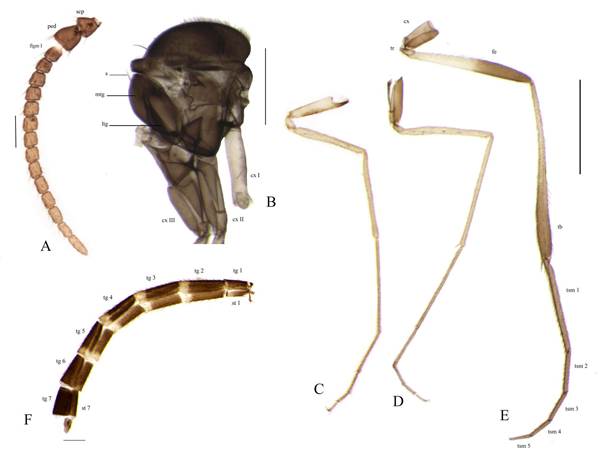
Abbreviations: cx = coxa; cx I-III = fore, middle and hind coxa; fe = femur; flgm 1 = flagellomere 1; ltg = laterotergite; mtg = mediotergite; Ped = pedicel; s = seta; scp = scape; st 1, st 7 = abdominal sternites 1 and 7, respectively; tb = tibia; tg 1-7 = abdominal tergites 1-7; tr = trochanter; tsm 1-5 = tarsomeres 1-5.
Figure 1 Lygistorrhina (Probolaeus) acahuizotla sp. nov. Male, Holotype. A) Antenna, lateral view; B) Thorax, lateral view; C-E) Legs, lateral view, C) Fore leg, D) Middle leg, E) Hind leg; F) Abdomen, lateral view. Scales: A = 0.1 mm; B, F = 0.5 mm; C-E = 1.0 mm.
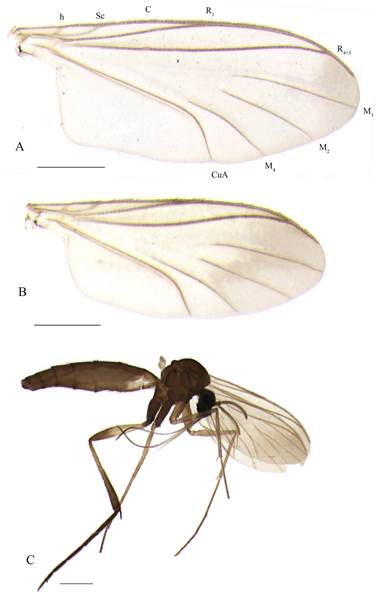
Abbreviations: C = costal vein; CuA = anterior branch of the cubital vein; h = humeral vein; M1, M2 and M4 = medial veins M1, M2 and M4, respectively; R1 and R4+5 = radial veins R1 and R4+5, respectively; Sc = subcostal vein.
Figure 2 Lygistorrhina (Probolaeus) acahuizotla sp. nov. A) Male wing, dorsal view; B) Female wing; C) Female, lateral view. Scales = 0.5 mm.
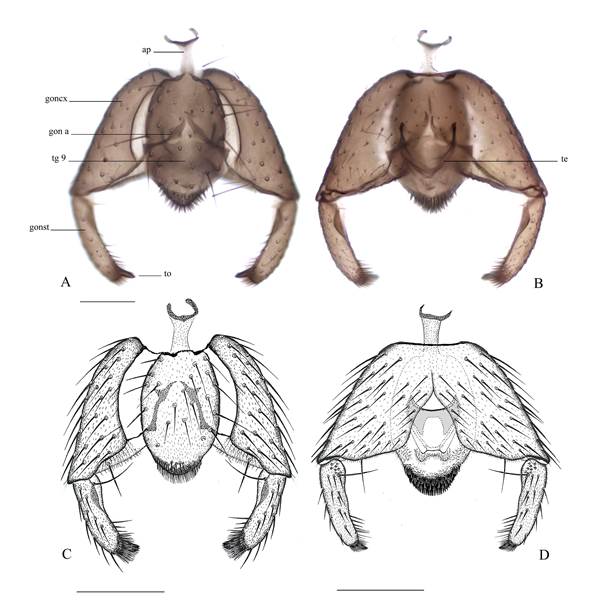
Abbreviations: ap = apodeme; goncx = gonocoxite; gon a = gonocoxal apodeme; gonst = gonostylus; tg 9 = tergite 9; te = tegmen; to = tooth apical.
Figure 3 Lygistorrhina (Probolaeus) acahuizotla sp. nov. Male terminalia, A, C) Dorsal view; B, D) Ventral view. Scales: A-B = 0.1 mm; C-D = 0.16 mm.
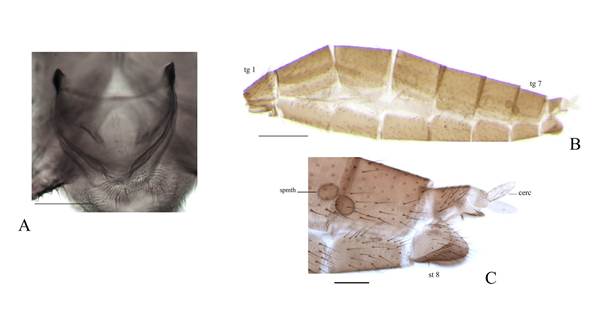
Abbreviations: cerc = cercus; tg 1, 7 = tergite 1 and 7; st 8 = sternite 8; spmth = spermatheca.
Scale: A = 0.05 mm; B = 0.5 mm; C = 0.05 mm.
Figure 4 Lygistorrhina (Probolaeus) acahuizotla sp. nov. A) Male, tegmen, ventral view; B-C) Female, abdominal segments, lateral view.
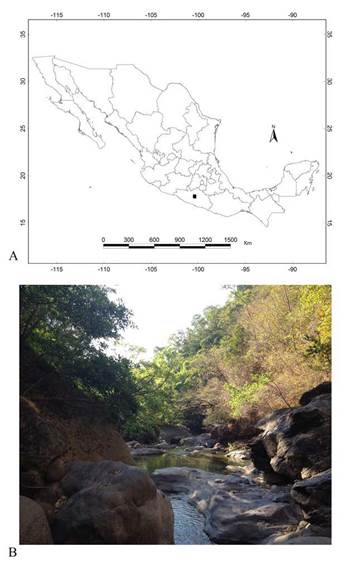
Figure 5 Lygistorrhina (Probolaeus) acahuizotla sp. nov. A) Distribution, solid black square; B) Type locality.
TYPE MATERIAL. Holotype (♂). MEXICO: Guerrero, Chilpancingo de Los Bravo, near the locality of Acahuizotla, 1.7 km southeast of Acahuizotla, site of “Las Bombas”, GPS: 17º 21´ 18.6´´ N, 99º 27´ 11.7´´ W; November 24, 2012; Malaise trap, Leg. Dzul-Manzanilla, F. Specimen preserved in Euparal®, deposited in the “Colección de Artrópodos con Importancia Médica (CAIM)”. Paratypes: 4 females, same holotype data (except specimens conserved in ethanol) deposited in CAIM.
Diagnosis. Only Neotropical species with the following combination of characters: Mediotergite with a pair of preapical setae (Fig. 1B); laterotergite with 17 setae; fore coxa pale-yellow, with brown pigmentation at middle, and middle and hind coxa dark brown (Fig. 1C-E); wing length 2.26 mm (Fig. 2B). Abdominal tergites and sternites 2-5 with a pale-yellow apical band (Fig. 1F); tegmen with mesial “U-shaped” (Fig. 4A). Female with the apical segment of the cercus longer than wide (Fig. 4B, C).
Male (Figs. 1A-F; 2A; 3A-D; 4A; 5A, B).
General coloration dark brown; length, 4.0 mm.
Head. Rounded, dichoptic. Vertex slightly convex. Rounded ommatidia with similar diameters, interocular setae similar to the length of the diameter of one ommatidium. Three ocelli arranged almost in a straight line, median ocellus slightly forward and the two laterally ocelli. Antenna dark brown (Fig. 1A), longer than head width, length, 0.80 mm; scape 1.4 times wider than long, with ventral setae; pedicel subcylindrical, with apical setae; flagellum dark brown, 14 flagellomeres, with reticulated appearance and setae present in all flagellomeres; first flagellomere subcylindrical, base paler; flagellomeres 2-6 with similar length, as long as wide, flagellomeres 7-13 subcylindrical, last flagellomere longer than previous ones, length, 0.085 mm. Face as long as wide, with distal and lateral setae. Clypeus with rounded apex. Palpus length, 1.6 mm, tapering towards apex, with a simple row of setae. Proboscis length, 1.8 mm.
Thorax (Fig. 1B). Dark brown. Scutum setose. Scutellum rounded, with 8 thin setae along posterior margin. Anterior pronotum with 10 thin setae. Proepisternum with 13 setae. Anepisternum and katepisternum bare, ventral margin slightly inclined. Pleural cleft marked. Laterotergite lobed, with a row of 17 dark setae. Metepisternum posterior margin longer than anterior margin. Mediotergite convex, with a pair of preapical setae (Fig. 1B).
Legs (Fig. 1C-E). Fore coxa cylindrical, pale-yellow, with a dark brown spot in the middle part; middle and hind coxa completely dark brown; fore coxa length, 0.63 mm; middle coxa length, 0.50 mm; hind coxa length, 0.37 mm. Femur and tibia of fore and middle leg pale-yellow; hind femur pale-yellow basally, dark brown distally, length, 1.27 mm; hind tibia brown, darker in the apical third, length, 1.87 mm; proportions femur / tibia: 0.69; fore and middle tarsus brown, hind tarsus dark brown, length of hind tarsomeres 1-5 (mm), respectively: 1.0, 0.45, 0.32, 0.25, 0.21; tibial spurs: 1: 1: 2; middle tibia with tibial spur 1.6 longer than the width of the tibia. Fore and middle tarsus brown, hind tarsus dark brown, typical rows of setae present. Claws of the fore and middle leg curved, apically blunt, with a small incision at the apex; claw of the hind leg setiform, straight and pointed.
Wing (Fig. 2A). Length, 2.65 mm; width, 1.07 mm. Membrane hyaline, densely covered with microtrichia; wing infuscated with a diffuse brown area at apex, at junction of C and R4+5, continuing towards posterior margin through M1, reaching distal portion of M2. Sc short, ending in C; h slightly oblique; R1 straight, 0.55 of wing length; R4+5 almost straight, slightly curved towards apex, 0.89 of the wing length; C extending beyond tip of R4+5. C, R1 and R4 + 5 with dark setae; Rs scarcely noticeable to base of wing; apical third of M1, M2 and M4 present; M1 length, 1.0 mm; M2 length, 0.77 mm; M4 length, 0.72 mm; r-m very tenuous, oblique, displaced towards base of wing; CuA straight, curved toward apex, ending at same level as R1. Cubital fold parallel closed to CuA. Anal lobe well developed. CuP very faint. Halter white, 1.9 length of first abdominal segment.
Abdomen (Fig. 1F). Dark brown; length, 3.63 mm. Sternite 1 pale-yellow apically; segments 2-5 with pale-yellow apical band; last two segments and terminalia dark brown; abdomen length in relation to wing length 1.25.
Terminalia (Figs. 3A-D; 4A). Tergite 9 1.6 times longer than wide; length, 0.24 mm; posterior margin rounded, provided with a patch of thick apical setae; apodeme of tergite 9 short, 0.4 the length of tergite; gonocoxite robust, 1.5 times longer than wide, ventrally fused for less than half of the total length, incision “V-shaped”. Gonocoxal apodeme “V-shaped”. Gonostylus with basolateral apophysis, basomesal incision and basal setae, an apical tooth and a dense patch of setae; length, 0.16 mm. Aedeagal complex membranous, except for sclerotized basal apodeme; length, 0.11 mm; width, 0.10 mm; tegmen “U-shaped” medially. Cercus short.
Female (Figs. 2B, C; 4B, C).
Similar to male. General coloration dark brown (Fig. 2C).
Head. Palpus length, 1.25 mm. Labella length, 1.95 mm. Clypeus with 9-10 setae. Antenna 1.4 times in relation to head width; length, 0.65 mm, with 14 flagellomeres, uniformly dark brown, except for base of first flagellomere.
Thorax. Dark brown, scutellum with 8 setae; mediotergite without setae; laterotergite lobulated, with 16-17 setae.
Legs. Coxae dark brown, fore coxa paler than hind coxae; length of the coxae: fore coxa, 0.65 mm; middle coxa, 0.40 mm; hind coxa, 0.35 mm. Coxae with a apical transversal row of rigid setae: fore coxa with 4-5 setae, middle coxa with 7-8 setae and hind coxa with 3 setae. Femur and tibia of fore and middle leg yellow brown. Hind femur pale-yellow on 0.57 of length of segment, rest of segment dark brown; length, 1.0 mm. Hind tibia yellowish brown, apical third dark brown; length, 1.45 mm. Femur / tibia proportion, 0.68. Tibial spurs of hind leg similar in length; hind tarsus dark brown, length of hind tarsomeres 1-5 (mm), respectively: 0.7, 0.35, 0.27, 0.20, 0.17; tibial spurs: 1: 1: 2; hind tarsus brown; claws similar on all legs.
Wing (Fig. 2B). Length, 2.25-2.28 mm (2.26 mm, n = 2); width, 0.90 mm (n = 2); wing infuscated with a diffuse brown mark at the apex, at junction of C and R4+5, continuing towards posterior margin through M1, and reaching the middle portion of M4. Sc ending in C; h slightly oblique; R1 elongated, 0.52 times of wing length; R4+5 with a row of setae, except the base; C extends beyond the tip of R4+5; Rs scarcely noticeable; apical third of M1, M2 and M4 present, M1, length, 0.82 mm; M2, length, 0.77 mm; M4, length, 0.90 mm; CuA straight, curved towards apex. Halter white, stem with 3-4 setae.
Abdomen (Fig. 4B, C). Uniformly dark brown; length, 2.63 mm; abdomen length in relation to the wing of 1.16; sternite 8 1.2 times longer than wide, apically rounded. Spermathecae oval (Fig. 4C), similar in proportion, with the following measures for each spermathecae: length, 0.062-0.065 mm (0.063 mm, n = 2); width, 0.050-0.052 mm (0.051 mm, n = 2), length, 0.057-0.060 mm (0.058 mm, n = 2), width, 0.050-0.052 mm (0.051 mm, n = 2). Cercus pale; apical segment of the cercus longer than width; length, 0.1 mm; length / width ratio 3.6.
Discussion
The association between males and females in the material examined in this study was based on the general color of the specimens (mainly the wing pattern and legs) and also considering the date of collection with the same trap and under the same conditions.
The male Lygistorrhina (Probolaeus) acahuizotla sp. nov., is similar to L. (P.) alexi and L. (P.) borkenti by the dark apex of the wing and the color of the abdomen. Lygistorrhina borkenti shows differences on the pale-yellow apical bands over abdominal tergites 2-4 and dark brown coxae; in contrast, L. alexi and L. acahuizotla present pale-yellow apical bands over tergites 2-5 and only the fore coxa is pale-yellow. Lygistorrhina acahuizotla differs from L. alexi, by the presence of a pair of apical setae in the mediotergite and pale-yellow fore coxa with a dark brown spot antero-medially.
Other species described for the Neotropical Region with similar coloration are Lygistorrhina (Probolaeus) barretttoiLane, 1947, L. brasiliensisEdwards, 1932, L. cerqueiraiLane, 1958, L. edwardsiLane, 1947, L. singularis (Williston, 1896) and L. urichiEdwards, 1912. However, certain species differ by the brown distal spot of the wing. Lygistorrhina acahuizotla is distinguished mainly from L. cerqueirai, by diffuse brown area at apex of wing, in L. cerqueirai has several wide spots in the wing; Sc ends in C, while in L. cerqueirai, Sc is free, not end in C; middle coxa dark brown, while in L. cerqueirai, middle coxa pale-yellow with spot medially. The remaining group of Neotropical species, including the new Mexican species, has a pale yellow/dark brown pattern on the hind femur, except for L. singularis, that present the hind femur completely pale-yellow.
Lygistorrhina acahuizotla differs from L. brasiliensis (Brazil) and L. urichi (Trinidad) mainly by the fore coxa color, pale-yellow with a dark brown spot anteriorly and the wide brown apical spot at wing apex, while in the other species the fore coxa is yellow brown and the apical spot of the wing is small and weakly marked.
Lygistorrhina barretttoi and L. edwardsi (both from Brazil), only known by the description of the female, and differs of L. acahuizotla by halter yellowish and abdomen with apical bands, while in Mexican species, halter white and abdomen dark brown.
Lygistorrhina (Probolaeus) sanctaecatharinae is the only known species in the Nearctic region. It differs from male of L. acahuizotla due to the pale-yellow apical bands on tergites 2-4, different from the pale-yellow apical bands shown on tergites 2-5 of L. acahuizotla. Sc is free and the fore coxa is dark brown in L. sanctaecatharinae, while in the Mexican species Sc ends in C and the fore coxa is pale-yellow basally. Females differ basically in the characteristic of Sc (as in males), and in the color of hind femur; in L. acahuizotla it is pale-yellow on the basal three fourth of the segment, dark brown distally, while in L. sanctaecatharinae the basal third is pale-yellow, the rest of the segment dark brown.
Most of the descriptions of Neotropical species are based on external coloration, and only some species include details of male terminalia. Lygistorrhina acahuizotla differs from all Neotropical species due to the membranous aedeagal complex and the “U-shaped” tegmen.
DISTRIBUTION. Mexico (Guerrero), only the type locality. Altitude 791 m. (Fig. 5A, B).
The locality of Acahuizotla, belong to the municipality of Chilpancingo de los Bravo, southwest of the state of Guerrero (Fig. 5). It has an altitude from 800-2,600 m, and is located between the coordinates 17° 17´ and 17° 25´ N, 99° 22´ and 99° 28´ W, in the Sierra Madre del Sur. The climate is semi-warm to semi-humid with an annual average of 1,373 mm of precipitation and an average annual temperature of 22.4°C (Velázquez, 2010). The vegetation is pine-oak forest, tropical deciduous forest, gallery forest and induced grassland. It is an area with the confluence of Nearctic and Neotropical elements (Ojendiz-Aley & Rodríguez-López, 2011).
ETIMOLOGY. The name of acahuizotla is in reference to name the type locality in the state of Guerrero. The epithet of the species is a noun in apposition.
Lygistorrhina (Probolaeus) alexi Huerta & Ibáñez-Bernal
Lygistorrhina (Probolaeus) alexiHuerta and Ibáñez-Bernal, 2008: 45. (male, female; figures: wing, antenna, thorax, hing leg, claw, terminalia male, tergite 9, spermathecae, distribution). Oliveira and Amorim, 2012: 3 (catalogue of Neotropical Lygistorrhinidae); Fungus Gnats Online (classification).
Comments. Previously known from the natural reserve of Ria Lagartos and Ria Celestun, in the state of Yucatán (Huerta & Ibáñez-Bernal, 2008). During the examination of specimens collected from the states of Guerrero (locality of Nuxco) and Jalisco (Biological Station of Chamela), and in comparison, with the type material of collection CAIM, these specimens are conspecific with Lygistorrhina (Probolaeus) alexi. This species has been specifically collected in lowland areas close to sea level, compared to the other Mexican species collected at higher altitudes and in forested regions.
New records
MEXICO, Jalisco, Estación de Biología Chamela, Cuenca 1, TM 339, January 8-13, 1993, Col. A. Rodríguez-Palafox, 1 female, CAIM 01045 (slide in Euparal).
MEXICO, Guerrero, locality Nuxco, municipality of Tecpan de Galeana, mango orchard, Malaise trap, February 08, 2013, GPS: 17° 11´ 45.2´´ N, 100° 46´ 6.79´´ W; 15 m a.s.l, Col. Morales-Ríos, E., 1 male. CAIM (slide in Euparal).
Identification key for species of Lygistorrhina Skuse from Mexico
1.- Middle tibia with one apical spur. . . . . . . . . . (Subg. Probolaeus Williston). . . . . . . . . . . . . . . . . . . . 2
.- Middle tibia with two apical spurs. . . . . . . . . . (Subg. Lygistorrhina Skuse). . . . . . . Lygistorrhina sp.
(Mexico: Hidalgo)
2(1).- Male. . . . . . . . . . . . . . . . . . . . . . . . . . . . . . . . . . . . . . . . . . . . . . . . . . . . . . . . . . . . . . . . . . . . . . . . . . . 3
.- Female. . . . . . . . . . . . . . . . . . . . . . . . . . . . . . . . . . . . . . . . . . . . . . . . . . . . . . . . . . . . . . . . . . . . . . . . . 5
3(2).- Abdomen with apical pale-yellow band on tergites 2-4; coxae dark brown. . . . . . . . . . . . . . . . . . . . . . . . . . . . . . . . . . . . . . . . . . . . . . . . . . . . . . . . . . . . . . . . . . . . . . . . . . . . . . . . . . borkenti Huerta & Ibáñez-Bernal
(Parque Nacional “Lagunas de Zempoala”)
.- Abdomen with apical pale-yellow band on tergites 2-5 (Fig. 1F); fore coxa pale-yellow, middle and hind coxa brown red or dark brown. . . . . . . . . . . . . . . . . . . . . . . . . . . . . . . . . . . . . . . . . . . . . . . . . . . . . . . . 4
4(3).- Mediotergite with a pair of preapical setae (Fig. 1B); fore coxa pale-yellow with dark brown pigmentation in the middle part (Fig. 1C). . . . . . . . . . . . . . . . . . . . . . . . . . . . . . . . . . . . . acahuizotla sp. nov.
(Guerrero, Acahuizotla)
.- Mediotergite without setae; fore coxa uniformly pale-yellow. . . . . . . . . alexi Huerta & Ibáñez-Bernal
(Jalisco, Guerrero, Yucatán)
5(2).- Fore coxa pale-yellow; apex of wing with a spot dark brown situated between R4+5 and C; laterotergite with 12-13 setae. . . . . . . . . . . . . . . . . . . . . . . . . . . . . . . . . . . . . . . . . . . . . . . . . alexi Huerta & Ibáñez-Bernal
(Jalisco, Guerrero, Yucatán)
.- Fore coxa dark brown; apex of wing with a spot dark brown diffuse situated from joint of R4+5 and C, extending to M2 (Fig. 2B); laterotergite with 16-17 setae. . . . . . . . . . . . . . . . . . . . . . . . acahuizotla sp. nov.
(Guerrero)











 nova página do texto(beta)
nova página do texto(beta)


